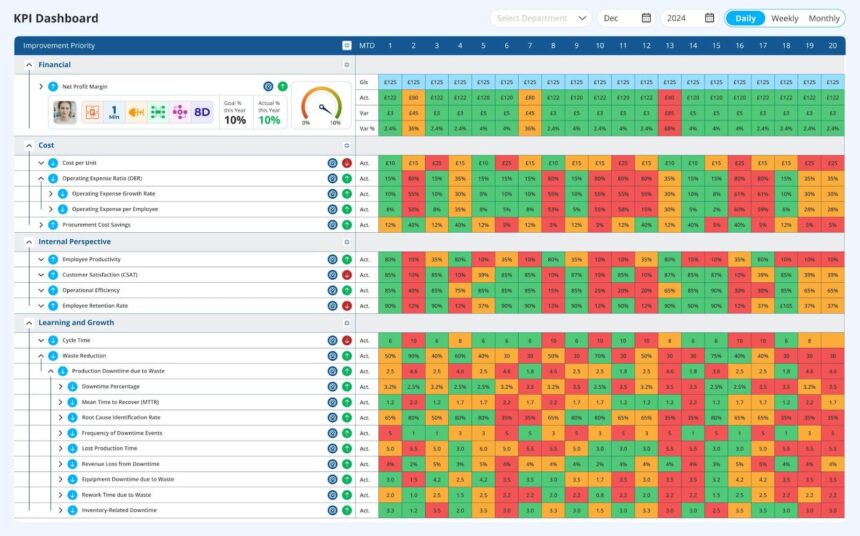In a competitive landscape where agility and precision drive success, organisations must rely on data, not intuition, to make strategic decisions. The Balanced Scorecard offers a structured framework to align strategic objectives with operational performance, helping companies stay focused, efficient, and future-ready.
What Makes the Balanced Scorecard So Effective in Measuring Strategy?
The Balanced Scorecard is more than a reporting tool — it’s a strategic management system that translates business vision into actionable metrics. It provides a 360-degree view of performance through four essential perspectives:
- Financial Perspective: Tracks profit, cost control, and revenue growth to ensure financial stability.
- Customer Perspective: Measures satisfaction, loyalty, and market perception to strengthen customer relationships.
- Internal Process Perspective: Analyses process efficiency, quality, and innovation across departments.
- Learning & Growth Perspective: Focuses on workforce skills, technology adoption, and cultural development.
By connecting these dimensions, organisations move beyond financial snapshots to a deeper understanding of what drives performance — and how to improve it continuously.
How Do Digital Tools Transform Traditional Scorecards?
Traditional scorecards often lag behind business realities. Teams rely on outdated spreadsheets or manual reporting cycles, which can obscure insights and slow reactions. Modern technology changes that. With advanced Balanced scorecard software, companies gain a living, breathing system that delivers real-time visibility across operations.
Dashboards integrate live data from multiple sources, showing performance indicators as they evolve. Managers can track productivity, quality, and customer outcomes on demand, making quick, informed decisions that align with strategic priorities.
Example:
A logistics company uses a digital scorecard to monitor delivery performance. When on-time rates drop, managers can pinpoint the cause — such as a delay in one regional hub — and act immediately. What used to take weeks of analysis now happens in minutes, helping them maintain service excellence while reducing costs.
A logistics company uses a digital scorecard to monitor delivery performance. When on-time rates drop, managers can pinpoint the cause — such as a delay in one regional hub — and act immediately. What used to take weeks of analysis now happens in minutes, helping them maintain service excellence while reducing costs.
This agility demonstrates why the Balanced scorecard remains a cornerstone of modern performance management. It empowers teams to turn information into action, fostering a culture of responsiveness and accountability.
Why Choose LTS Data Point for Your Digital Balanced Scorecard?
For organisations seeking a cutting-edge solution, LTS Data Point balanced scorecard software — the digital balanced scorecard with real-time features delivers everything needed to transform strategy into measurable success.
Unlike static dashboards, LTS Data Point integrates real-time analytics, AI-driven insights, and customisable KPIs to keep your strategy alive and adaptive. Its intuitive interface allows every department — from finance to operations — to track performance, identify gaps, and take immediate action. The platform’s automation capabilities reduce reporting overhead, while built-in visualisation tools simplify complex data for leadership teams.
LTS Data Point also promotes strategic alignment across your organisation. Whether you’re tracking profitability, innovation, or employee engagement, it provides a unified view that ensures every action supports your long-term goals. With secure cloud access, continuous updates, and flexible integration options, it’s not just software — it’s your organisation’s digital command centre for performance excellence. Take the next step toward intelligent strategy execution and elevate your performance management, drive accountability, and keep your strategy in motion — every single day.


